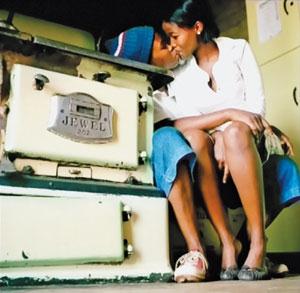“I call myself a visual activist because what I’m doing is radical and it’s based on political issues,” South African photographer Zanele Muholi says at the beginning of her award-winning documentary Difficult Love.
Five years of Muholi’s work, stored on digital memory cards and 20 external hard drives, was stolen from her Cape Town apartment in April in a seemingly targeted burglary.
The thief or thieves left a flat-screen TV, DVD player, expensive camera, printer, projector and brand-new cellphones behind, choosing, instead, to carry off what is considered to be a one-of-a-kind record of marginalized black lesbians in several African countries.
It’s an archive that challenges African patriarchy, traditionalists and religious fundamentalism, movingly portraying the love and sensuality of black lesbians, the quotidian ordinariness of their lives, and the ways they create community, even as it documents the global-headline-making homophobic violence that is visited on their bodies to “correct” their desire.
Difficult Love’s most painful scene is an interview with a woman, one eye swollen shut, the other tear- and injury-reddened, her voice reduced to a hoarse whisper because she screamed throughout a five-hour sexual assault.
Muholi’s relentless witness is an indictment of the legal promise of South Africa’s constitution that outlaws discrimination based on sexual orientation and enshrines the right to gay marriage.
“I want people to know more about our lives as black lesbians,” she says. “We come from families, we have friends, we work, we think, we care, we conscious — there’s so much going on in our lives, so I want people to know that we are here and we are part and parcel of this democracy. Our history — somewhere, somehow — got distorted.”
While her work is revered in many quarters as a significant part of South Africa’s cultural heritage — Richard Lee of the NGO Open Society Initiative for Southern Africa reportedly compared the loss of Muholi’s work to the theft of a painting by Picasso in Europe — others feel threatened by it.
To former South African arts and culture minister Lulu Xingwana, the lushly photographed images of black lesbians embracing was “immoral” and “against nation-building.”
Sentiments similar to Xingwana’s are echoed in Difficult Love as Muholi canvasses opinion about homosexuality and her work. Many are familiar clichés: God made Adam and Eve, not Adam and Steve; how can a man and a man do that; and the favourite mantra that homosexuality is un-African and is a white phenomenon.
Muholi assembles a cadre of talking heads to counter these views.
“We’ve all imbibed this very untrue statement that homosexuality is non-African,” says gender and political analyst Nomboniso Gasa. “But we have passed it through so many generations that it has almost become a truism. A truism that is not borne out by facts whatsoever.”
Ultimately, it’s Muholi’s work that delivers a defiant and eloquently visual dismissal of these accepted but increasingly challenged myths about gay African lives.
Added to this already volatile mix, Muholi also navigates the bogeymen of race and class in interracial lesbian relationships, in life and her work.
“We are ’70s babies. We come from the same era. She experienced apartheid from one side and I from the other, so I think there are many things we can talk about, many things to sort out,” says Muholi’s partner, Liesel Theron, who is white.
“Everything in our lives has to do with class and race . . . I think it’s just more prominent in our lives,” Theron says of her relationship with Muholi.
In different spaces, Muholi observes, people look at the white madam and do not acknowledge the black person in their midst. “I just cannot imagine having Liesel working for me as a black master and a white slave; it’s always the other way around,” says Muholi, who clearly wondered about it enough to stage and photograph such scenarios.
“No one else has taken photos like this,” Lee writes. “No one else has documented this community with so much understanding and so much force and so much beauty.”


 Why you can trust Xtra
Why you can trust Xtra


